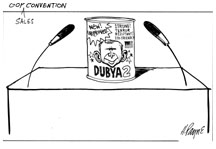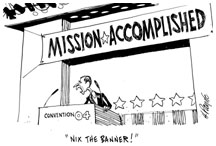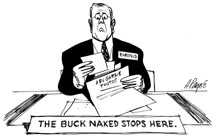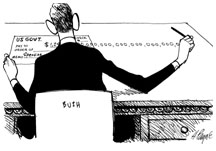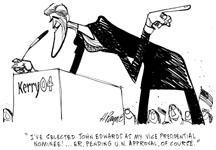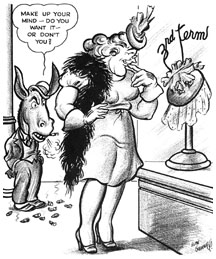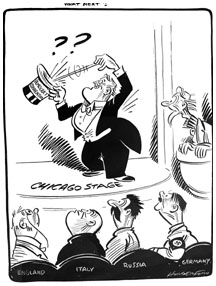October 6, 2004: Features
(all Henry Payne Cartoons: ©2004 United Feature Syndicate) PawPlus
online: |
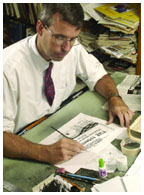
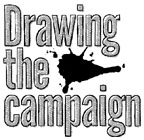
Henry Payne ’84 is seriously funny
By Brett Tomlinson
(Photo: WAYNE SMITH/THE DETROIT NEWS; HEADLINE Title illustration: STEVEN VEACH)
For most readers, the newspaper provides information. For editorial cartoonist Henry Payne ’84, it provides inspiration. Each morning, Payne sits at his desk at the Detroit News and scans the papers for topics that would make his audience chuckle – or at least think twice. What is President Bush talking about today? Where’s John Kerry’s campaign bus headed? Anything ironic within the grim news from Iraq? Finding stories is easy. The challenge is turning them into something fresh and incisive, within the confines of a single rectangular panel.
In a city driven by manufacturing, Payne employs his own sort of assembly line. Starting with a foundation of ideas gleaned from the headlines, he frames a setting and fashions an assortment of carefully drawn features – a tuft of hair blow-dried to perfection, a lantern jaw protruding under sorrowful eyes, sparkling teeth on loan from a toothpaste ad. Humorous props add polish to the product, and with a few strokes of the pen, he seals his creation with its essential adhesive: the punch line.
“My dad [Henry Payne III *60] has a business that manufactures power controls,” Payne says, “and I know he gets a real joy out of having a product at the end of the manufacturing line. And I enjoy being able to make a statement, a cartoon, out of an issue.”
Payne’s readers enjoy the results. The process has not changed a great deal in the two decades since Payne left his cartooning post at the Daily Princetonian, but his audience has grown considerably. His work is now seen by 270,000 daily readers in Detroit, and is distributed nationally by the United Features Syndicate. And as November approaches, Payne is sketching his way through the political cartoon’s most incisive season: the presidential campaign. The 2000 election provided constant fodder for cartoonists, thanks in part to the Florida recounts, and 2004 is shaping up to be equally entertaining. “It’s exciting that people are interested in these subjects in a way they’re not in an off-political year,” Payne says.
Drawing the campaign requires an eye for detail – a cartoon is not nearly as funny if you have to label the characters – and Payne has a solid handle on this year’s candidates. George W. Bush, he says, was initially challenging to draw because of his somewhat nondescript face. “Fortunately, his father preceded him, so I was familiar with the family features,” Payne says. “W. looks a lot like his dad, but he’s also got his mother’s nose, his mother’s nostrils, and close-set eyes.” Compared to the president, John Kerry was an easy caricature. “Kerry has a jaw that goes down to his knees,” Payne says. “He’s got the blow-dried hair, and he’s got these great sorrowful eyebrows that are similar to the ones that George W. Bush has.”
A good cartoon character, however, also needs a prop. Snoopy has his doghouse, Linus has his blanket, and Bush has his propensity to stumble over words. Humorists have cast Bush as dim-witted and tagged Kerry as indecisive. One Payne cartoon showed Bush on a campaign stop on Michigan’s upper peninsula, using a U.N.-style translator to understand the native “Yuppers.” The Democratic ticket got the Payne treatment in a cartoon of the “Democrat Café,” serving “Waffle and Grits.”
Payne, a political conservative, is more apt to focus on Kerry’s missteps, but he also pays attention to Bush’s flaws, which he says are plentiful. Varying topics, and targets, keeps the audience interested. “One of the advantages of being a conservative satirist is that you’re naturally suspicious of government,” Payne says. “Any politician is fair game.”
Do exaggerated chins and comic props pull attention away from the issues of the presidential campaign? Not really, Payne says. Punch lines rely on news and issues. Every politician has foibles, but ultimately, the events of the campaign define a candidate’s success or failure. And a good political cartoon brings those events into focus, providing perspective through comedy.
Historically, a handful of cartoonists have made an impact on politicians’ careers, with Thomas Nast’s role in the demise of 1870s Tammany Hall boss William Tweed being perhaps the best example. National Review columnist Andrew Ferguson once called Payne “the Thomas Nast of our day.”
Tweed, Payne says, exposed himself by admitting that Nast’s cartoons were hurting his credibility. “Stop them damn pictures,” Tweed reportedly pled. “I don’t care so much what the papers write about me. My constituents can’t read. But damn it, they can see pictures.” Today’s politicians tend to be more media savvy, as Payne learned during his 13 years as the cartoonist for the Scripps Howard News Service in Washington, D.C. Some even see cartoons as a sign of status. Prominent figures like Al Gore and Newt Gingrich have asked for original drawings from Payne after they were published.
As the political world has changed, so has the world of political cartoons, according to Stephen Hess, a former Pulitzer Prize judge and coauthor of Drawn and Quartered: The History of American Political Cartoons (1996). There are fewer than 200 full-time newspaper cartoonists in the United States, and television has far more influence on the fortunes of candidates. But good cartoonists still get noticed, Hess says, as long as they know their audience. “They have to draw what people understand instantly, so the nature of what you can draw has changed,” Hess says. “You don’t see many references to Hamlet or Macbeth anymore. You do see references to the latest TV shows.”
In an election year, the public is more attuned to politics, which expands the possibilities for political cartoons. Payne says he’s tempted to do campaign cartoons everyday, but he tries to stick to events and issues that people genuinely care about. Borrowing a concept from former Texas Sen. Phil Gramm, he employs a sort of “Dicky Flatt test.” Flatt was Gramm’s everyman, a constituent he kept in mind each time he considered the impact of a new law or regulation. Payne aims to reach readers who care about, but are not obsessed with, politics.
Payne’s punch lines can elicit a quick laugh – an initial gut response – or tackle weightier subjects, taking advantage of one of the benefits of political cartooning: You can be funny and flip one day, sober and hard-hitting the next, and back to flip the day after. But as a matter of style, his panels favor the funny. “There’s enough grim news in the world,” Payne says.
“I think audiences enjoy getting a good chuckle out of a cartoon.”
![]()
Brett Tomlinson is an associate editor at PAW.
"What next?" (Cartoons Courtesy Princeton University Archives) |
At Mudd: Cartoons take on FDR
Selections from the Seeley G. Mudd Manuscript Library’s collection of political cartoons are on display through Jan. 31 in an exhibition called “Testing Boundaries: Cartoon Visions of Roosevelt’s Third Term.” The 11 drawings on display reflect artists’ views of Franklin Delano Roosevelt’s controversial decision to run for re-election in 1940, breaking the two-term precedent established by George Washington.
In “The Easter Bonnet,” above, Rube Goldberg of the New York Sun depicted the Democrats’ frustration with FDR’s uncertain intentions. “What Next,” below, by Cy Hungerford of the Pittsburgh Post-Gazette, illustrated global anticipation of FDR’s decision.
Princeton’s political-cartoons collection includes nearly 1,000 original drawings published between 1890 and 1950, featuring the work of 16 Pulitzer Prize winners. “Testing Boundaries” is open Monday through Friday from 9 a.m. to 4:45 p.m., and until 8 p.m. on Wednesdays.
By B.T.




